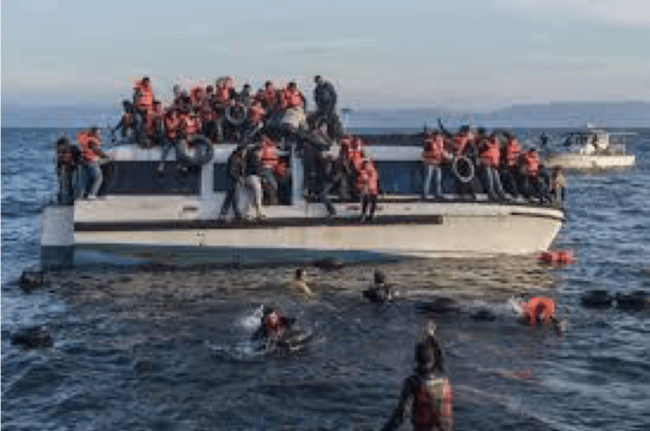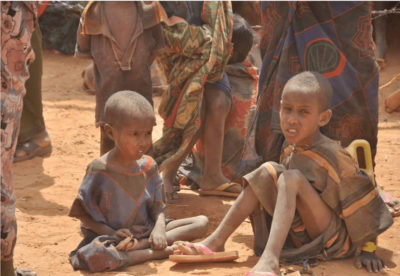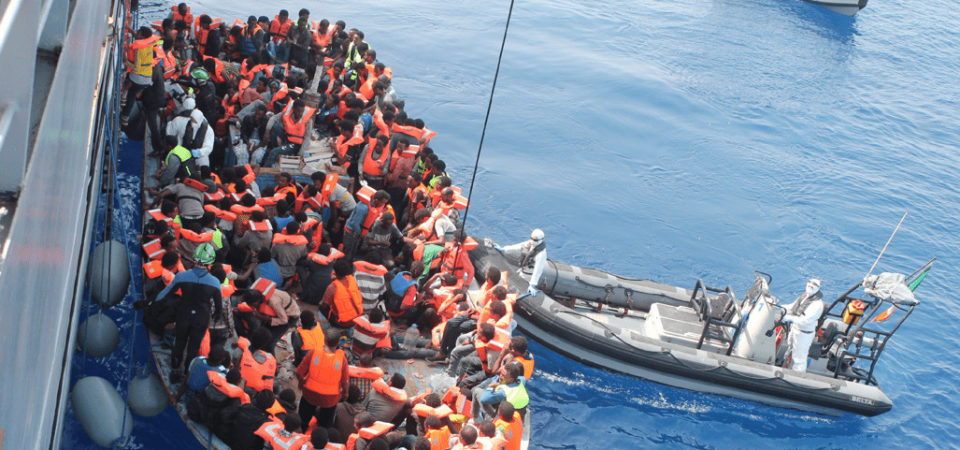File: Download
Date of Publication: December 2019
Publisher: The Millennium Alliance for Humanity and the Biosphere
Author(s): Gioietta Kuo-Petravic
Our Future Predictions
Overpopulation is the mother of all evils today. From it springs all the ills and destabilization we encounter in our society.
The ominous words of the 18th century philosopher Thomas Mathus is beginning to ring more and more true as time goes on. In an essay [1] on what he saw as the dire future of humanity he wrote: “Humans’ unquenchable urge to reproduce could ultimately lead us to overpopulate the planet, eat up all its resources and die in a mass famine.”
The urge to reproduce is a basic human instinct. One can but ask, “Why? is it intrinsic in the human evolution simply because of the survival of the species? In order to prevent the dying out of a species, we go to the extreme of overpopulation. This is so sad and in the end is so counterproductive!
An UN report in June 2019 says the present world population of 7.7 billion is due to become 9.7 billion in 2050 in 30 years time. By the end of the century, this could approach 11.2 billion.[2]
World population increase has peaked in the five-year period between 1985 and 1990, when 457 million were added to the world population. However, increases in world population have not declined much since then. Between 2010 and 2015, the world population grew by some 420 million people – not much less than in the late 1980s.
The number of people added to the world population in each subsequent five-year period is projected to decline – but only after 2050 will the numbers added to the world population be smaller than in the early 1950s.
![Figure 2 :UN forecast depending on what growth rate we can expect [ 3 ]](https://mahb.stanford.edu/wp-content/uploads/2019/12/G_Dec_2.png)
What is the earth’s carrying capacity and how many people can it support?[4]
Today, there are over 7.7 billion of us on this planet. Of these, 2 billion have been added after 1993 – in the last 26 years. According to the United Nations, our population is expected to reach 8.5 by 2030, 9.7 billion by 2050 and 11.9 billion by 2100. And that, many scientists believe, is the maximum carrying capacity of the earth.
Already we have hit a limit in measuring the ecological footprint of this burgeoning population – the amount of biologically productive land and water a person requires for producing the resources it consumes.
According to UN food and agriculture organization, 11% of our land surface is being used for growing crops. The world has only 60% of the water it needs.
NOTE: (According to [5] The United Nations World Water Development Report, Nature-based Solutions for Water, launched 19 March 2018 during the 8th World Water Forum, and in conjunction to the World Water Day, demonstrates how nature‐based solutions (NBS) offer a vital means of moving beyond business‐as‐usual to address many of the world’s water challenges while simultaneously delivering additional benefits vital to all aspects of sustainable development. )
While it needs 500 – 4000 liters of water to produce one kg of wheat, when it comes to livestock grazing, the needed area and water is much bigger. To produce one kg of beef it needs 15,415 liters. One kg of chicken meat necessitates 4325 liters of water. According to Harvard’s Edward O. Wilson [4], if everyone became vegetarian, then the earth carrying capacity could be 10 billion as far as food is concerned. A recent paper by a team of scientists in Nature Sustainability [6] concluded that the Earth can sustain at most only seven billion people at substance levels of consumption. Note that in June 2019 we are already at 7.7 billion. Achieving “high life satisfaction” for everyone, however, would transgress the Earth’s biophysical boundaries, leading to ecological collapse. Of course this depends on many economic, social, technical and other factors which is a challenge for us today.
Concentration of Growing Population
It is interesting to note that from 2017 to 2050, it is expected that half of the world’s population growth will be concentrated in just nine countries: India, Nigeria, the Democratic Republic of the Congo, Pakistan, Ethiopia, the United Republic of Tanzania, the United States of America, Uganda and Indonesia (ordered by their expected contribution to total growth), which stood at 4.3 births per woman in 2010-2015. However, the reasons for the high population growth for these countries are diverse, depending in part on history, government economic and social policies, education and welfare. As a result, the population of these countries has been growing rapidly, at around 2.4 % per year. Although this rate of increase is expected to slow significantly over the coming decades, the combined population of these least developed countries – LDCs, roughly one billion in 2017, is projected to increase by 33 % between 2017 and 2030, and to reach 1.9 billion persons in 2050.
Similarly, Africa continues to experience high rates of population growth. Between 2017 and 2050, the populations of 26 African countries are projected to expand to at least double their current size.
What is being done? The concentration of global population growth in the poorest countries presents a considerable challenge to governments in implementing the 2030 Agenda for Sustainable Development [ 2C ], During the 2012 United Nations Conference on Sustainable Development (Rio+20), member States agreed to launch a process to develop a set of sustainable development goals (SDGs) which seek to end poverty and hunger, expand and update health and education systems, achieve gender equality and women’s empowerment, reduce inequality and ensure that no one is left behind.
Aging of Global Population
People are living longer also. The global average life expectancy at birth increased from 64.2 years in 1990 to 72.,6 years in 2019. This is unfortunately expected to rise further to 77.1 years in 2050.
The ratio of older people over the supporting younger people is rising and putting pressure on social protection systems. In the coming decades this could cause extreme pressure as countries try to maintain public ecosystems of health care, pensions, and other social protections.
MIGRATION

Overpopulation has fueled migration across country and continent boundaries. International migration is a complex phenomenon encompassing economic, social and security
aspects in an increasingly interconnected world. Understandably, people living in poorer countries desire higher standards of living and access to opportunities for themselves and their children. Additionally, globalization continues to connect billions of people daily and highly functional transport systems provide incentives for people to move across borders in search of solutions for themselves and their families.
According to the UN in 2017 [7] more people than ever before live in a country other than the one in which they were born, this number of migrants reached 258 million. Those who are migrants out of necessity is around 68 million.- including over 25 million genuine refugees, 3 million asylum seekers and over 40 million internally displaced persons.
There are different categories of migration [8]. Some people move in search of labour or economic opportunities, to join family, or to study. Others move to escape conflict, persecution, terrorism, or human rights violations. Still others move in response to the adverse effects of climate change, natural disasters, or other environmental factors. Whether in search of a better life or forced to move due to increasingly stressed systems in their home countries, population growth in fueling migration.
The world’s migrant populations tend to come from a relatively small number of countries. In 2019, two thirds of all international migrants were living in just 20 countries. The largest number of international migrants (51 million) resided in the United States of America, equal to about 19 per cent of the world’s total. Germany and Saudi Arabia hosted the second and third largest numbers of migrants worldwide (around 13 million each), followed by the Russian Federation (12 million) and the United Kingdom (10 million) Turkey has the largest number of refugees hosting approximately 3.1 million, followed by the State of Palestine (2.2 million), Lebanon (1.6) and Pakistan (1.4 million), Germany(1.3 million)and Uganda (1.2 million) also hosted more than one million refugees and asylum seekers
Germany’s Cultural Problems with Muslim immigration
In 2015, because of war and unrest in the middle east – Iraq and Syria – The German Chancellor Angela Merkel, partly in view of the historical background of Holocaust and partly out of compassion, opened its borders and let in over a million migrants – refugees from those war torn countries. Her slogan was “wir kann” – we can-. Her basic instinct was that since Germany has huge financial resources it can therefore accept these people and give them good living benefits. Her cardinal mistake lies in the misunderstanding that while financially these people can be given reasonable conditions to live in Germany, many migrants have struggled to culturally assimilate in a predominately christian society. Over the past few years Germany has witnessed an increased struggle between communities with religious differences. Many Germans feel betrayed, that the ‘old Germany’ they cherished no longer exists. The resentment has led to the rapid rise of right wing populist parties like AFD which are anti- migrants. Very recently, Angela Merkel has admitted that the multiculturally society she had hoped to forge has been difficult to develop, leading to many unintended consequences for the county and many communities.
- CONCLUSION-
Already the earth has reached the 7 billion mark which is the subsistence level reported by Nature Sustainability [6]. The addition of more people affects EVERY aspect of our life and produces more stress for our society. Let us just enumerate here the most notable consequences of overpopulation:
- Increase use of our already diminishing resources: such as energy. Currently 75% of our energy come from fossil fuel and we know that it will only last 50-80 more years [9].
- Contribute to hunger and undernourishment. Already our agriculture is not able to feed our existing population and according to Unicef 2019 [10] more than 820 million people in the world were still hungry in 2018, underscoring the immense challenge of the UN Zero Hunger target by 2030. Hunger is on the rise in almost all African subregions leading to Africa having the highest prevalence of undernourishment in the world.

- More people Increases uncontrolled urbanization and expansion of cities. This necessitates more infrastructure and using up of resources.
- More people using up of resources Increase emission of carbon dioxide into the atmosphere resulting in climate change. Reduce the use of fossil fuel and change to alternative renewable energy and nuclear power.
As for migration, many migrants come from the least development countries where poor governance is exploited by cartels resulting in violence and impossibility of living conditions. Much can be done through political negotiations at the highest level.
One has to admit that a certain amount of migration can be beneficial in releasing the social economic and security pressures in a nation. For example, it can help to support an aging population in certain circumstances. But massive uncontrolled immigration as is happening in many countries today like in USA, Germany, France, Italy, Turkey and Greece can only exacerbate and stress the existing welfare infrastructures and serve only to destabilize these societies. Migration is fueled by population, the sooner we recognize this the sooner we will be able to address the core issue.
—————————————————————————–
Gioietta Kuo, MA at Cambridge, PhD in nuclear physics, Atlas Fellow at St Hilda’s College, Oxford and Princeton University plasma physics lab, is a research physicist. Over 70 professional articles and over 100 articles in environmental problems – in World Future Society-wfs.org, amcips.org, MAHB Stanford and other worldwide think tanks. Also in Chinese in ‘ People’s Daily’ and ‘World Environment’ – Magazine of the Chinese Ministry of Environmental Protection, and others in China. She can be reached at <kuopet@comcast.net.>
REFERENCES
https://population.un.org › wpp › Publications › Files › WPP2019_Highlig…
https://www.un.org › development › desa › publications › world-populatio…
C.Sustainable Development Goals – the United Nations
https://www.un.org › development › desa › disabilities › envision2030
geoawesomeness.com/earths-capacity-many-people…
www.unwater.org/publications/world–water..
www.reddit.com/r/environment/comments/94iila/in…
www.un.org/development/desa/publications/…
www.iom.int/wmr/world–migration–report-2018
- When fossil fuels run out, what then?
May 2019
https://mahb.stanford.edu/library-item/fossil-fuels-run/
10. The state of food security and nutrition in the world 2019 …
The views and opinions expressed through the MAHB Website are those of the contributing authors and do not necessarily reflect an official position of the MAHB. The MAHB aims to share a range of perspectives and welcomes the discussions that they prompt.
